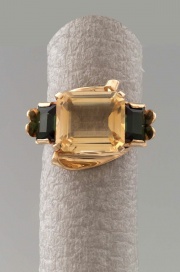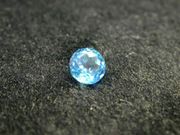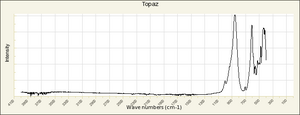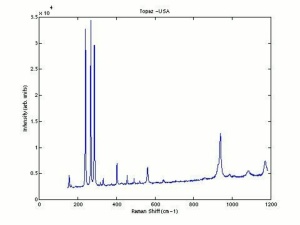Difference between revisions of "Topaz"
| (3 intermediate revisions by the same user not shown) | |||
| Line 3: | Line 3: | ||
An aluminum silicate mineral used as a semiprecious [[gemstone|gemstone]]. Topaz is usually yellow but may also be colorless, blue, brown, or pink. The transparent to translucent stone occurs most often in rocks of the [[granite|granite]] and [[rhyolite|rhyolite]] type. Some sources of topaz are the Ural Mountains, Ilmen Mountains, Sri Lanka, Germany (Saxony), Norway, Sweden, Siberia, Scotland, Japan (Takayama, Tanokamiyama), Brazil (Minas Gerais), Mexico, and the U.S. (New England, Texas, Utah, Colorado, California). In the Middle Ages, all yellow stones were called topaz. In 1750, it was noted that yellow Brazilian topaz would turn red when heated and these were sold as Brazilian rubies. | An aluminum silicate mineral used as a semiprecious [[gemstone|gemstone]]. Topaz is usually yellow but may also be colorless, blue, brown, or pink. The transparent to translucent stone occurs most often in rocks of the [[granite|granite]] and [[rhyolite|rhyolite]] type. Some sources of topaz are the Ural Mountains, Ilmen Mountains, Sri Lanka, Germany (Saxony), Norway, Sweden, Siberia, Scotland, Japan (Takayama, Tanokamiyama), Brazil (Minas Gerais), Mexico, and the U.S. (New England, Texas, Utah, Colorado, California). In the Middle Ages, all yellow stones were called topaz. In 1750, it was noted that yellow Brazilian topaz would turn red when heated and these were sold as Brazilian rubies. | ||
| − | |||
[[File:Topazemr1.jpg|thumb|Topaz]] | [[File:Topazemr1.jpg|thumb|Topaz]] | ||
[[File:pt20825topazsyn.jpg|thumb|Synthetic blue topaz]] | [[File:pt20825topazsyn.jpg|thumb|Synthetic blue topaz]] | ||
| Line 9: | Line 8: | ||
hyacinth (dark orange); Brazilian ruby; Topas (Deut.); topacio (Esp.); topaze (Fr.); topaas (Ned.); topázio (Port.) | hyacinth (dark orange); Brazilian ruby; Topas (Deut.); topacio (Esp.); topaze (Fr.); topaas (Ned.); topázio (Port.) | ||
| − | + | [[[SliderGallery rightalign|Topaz IR-ATR RRUFF R040121.png~IR-ATR (RRUFF)|Topaz Raman RRUFF R040121.png~Raman (RRUFF)|topazRS.jpg~Raman (RASMIN)|Topazitaly1.jpg~Raman (U of Parma)]]] | |
| − | [[[SliderGallery rightalign|topazRS.jpg~Raman|Topazitaly1.jpg~Raman]]] | ||
== Physical and Chemical Properties == | == Physical and Chemical Properties == | ||
| − | * Orthorhombic system with mostly prismatic crystals | + | * Orthorhombic system with mostly prismatic crystals |
| − | * Perfect cleavage in one direction | + | * Perfect cleavage in one direction |
| − | * Fracture = subconchoidal and uneven | + | * Fracture = subconchoidal and uneven |
| − | * Luster = vitreous | + | * Luster = vitreous |
| − | * Streak = colorless to white | + | * Streak = colorless to white |
| − | * Yellow topaz turns a soft red when heated | + | * Yellow topaz turns a soft red when heated |
| − | * Fluorescence | + | * Pleochroism = weak to moderate; light red, orange to yellow, violet-bluish |
| + | * Fluorescence = may show yellowish color (SW) and cream color (LW) | ||
| + | * Inclusions = 2- and 3-phase inclusions; liquid inclusions in planes | ||
{| class="wikitable" | {| class="wikitable" | ||
| Line 34: | Line 34: | ||
! scope="row"| Refractive Index | ! scope="row"| Refractive Index | ||
| 1.61; 1.61; 1.63 | | 1.61; 1.61; 1.63 | ||
| + | |- | ||
| + | ! scope="row"| Birefringence | ||
| + | | 0.008 - 0.010 | ||
|} | |} | ||
| Line 41: | Line 44: | ||
==Resources and Citations== | ==Resources and Citations== | ||
| + | * Gem Identification Lab Manual, Gemological Institute of America, 2016. | ||
* Mineralogy Database: [http://www.webmineral.com/data/Topaz.shtml Topaz] | * Mineralogy Database: [http://www.webmineral.com/data/Topaz.shtml Topaz] | ||
| − | |||
* Jack Odgen, ''Jewellery of the Ancient World'', Rizzoli International Publications Inc., New York City, 1982 | * Jack Odgen, ''Jewellery of the Ancient World'', Rizzoli International Publications Inc., New York City, 1982 | ||
| − | |||
* R.F.Symmes, T.T.Harding, Paul Taylor, ''Rocks, Fossils and Gems'', DK Publishing, Inc., New York City, 1997 | * R.F.Symmes, T.T.Harding, Paul Taylor, ''Rocks, Fossils and Gems'', DK Publishing, Inc., New York City, 1997 | ||
| − | |||
* A.Lucas, J.R.Harris, ''Ancient Egyptian Materials and Industries'', Edward Arnold Publishers Ltd., London, 4th edition, 1962 | * A.Lucas, J.R.Harris, ''Ancient Egyptian Materials and Industries'', Edward Arnold Publishers Ltd., London, 4th edition, 1962 | ||
| − | |||
* ''Encyclopedia Britannica'', http://www.britannica.com Comment: "topaz" [Accessed December 4, 2001]. (color photo)(tech info) | * ''Encyclopedia Britannica'', http://www.britannica.com Comment: "topaz" [Accessed December 4, 2001]. (color photo)(tech info) | ||
| − | |||
* C.W.Chesterman, K.E.Lowe, ''Audubon Society Field Guide to North American Rocks and Minerals'', Alfred A. Knopf, New York, 1979 | * C.W.Chesterman, K.E.Lowe, ''Audubon Society Field Guide to North American Rocks and Minerals'', Alfred A. Knopf, New York, 1979 | ||
| − | + | * Wikipedia: [https://en.wikipedia.org/wiki/Topaz Topaz] (Accessed Sept. 17, 2005 and Dec 2022) | |
| − | * Wikipedia: | ||
| − | |||
* G.S.Brady, ''Materials Handbook'', McGraw-Hill Book Co., New York, 1971 Comment: p. 646 | * G.S.Brady, ''Materials Handbook'', McGraw-Hill Book Co., New York, 1971 Comment: p. 646 | ||
| − | |||
* ''Van Nostrand's Scientific Encyclopedia'', Douglas M. Considine (ed.), Van Nostrand Reinhold, New York, 1976 | * ''Van Nostrand's Scientific Encyclopedia'', Douglas M. Considine (ed.), Van Nostrand Reinhold, New York, 1976 | ||
| − | |||
* Random House, ''Webster's Encyclopedic Unabridged Dictionary of the English Language'', Grammercy Book, New York, 1997 | * Random House, ''Webster's Encyclopedic Unabridged Dictionary of the English Language'', Grammercy Book, New York, 1997 | ||
| − | |||
* ''The American Heritage Dictionary'' or ''Encarta'', via Microsoft Bookshelf 98, Microsoft Corp., 1998 | * ''The American Heritage Dictionary'' or ''Encarta'', via Microsoft Bookshelf 98, Microsoft Corp., 1998 | ||
| − | |||
* Website: http://www.geo.utexas.edu/courses/347k/redesign/gem_notes/Topaz/topaz_three_frames.htm (fluorescence information) | * Website: http://www.geo.utexas.edu/courses/347k/redesign/gem_notes/Topaz/topaz_three_frames.htm (fluorescence information) | ||
| − | |||
* ''CRC Handbook of Chemistry and Physics'', Robert Weast (ed.), CRC Press, Boca Raton, Florida, v. 61, 1980 Comment: density=3.5-3.6 | * ''CRC Handbook of Chemistry and Physics'', Robert Weast (ed.), CRC Press, Boca Raton, Florida, v. 61, 1980 Comment: density=3.5-3.6 | ||
Latest revision as of 13:30, 4 January 2023
Description
An aluminum silicate mineral used as a semiprecious Gemstone. Topaz is usually yellow but may also be colorless, blue, brown, or pink. The transparent to translucent stone occurs most often in rocks of the Granite and Rhyolite type. Some sources of topaz are the Ural Mountains, Ilmen Mountains, Sri Lanka, Germany (Saxony), Norway, Sweden, Siberia, Scotland, Japan (Takayama, Tanokamiyama), Brazil (Minas Gerais), Mexico, and the U.S. (New England, Texas, Utah, Colorado, California). In the Middle Ages, all yellow stones were called topaz. In 1750, it was noted that yellow Brazilian topaz would turn red when heated and these were sold as Brazilian rubies.
Synonyms and Related Terms
hyacinth (dark orange); Brazilian ruby; Topas (Deut.); topacio (Esp.); topaze (Fr.); topaas (Ned.); topázio (Port.)
Physical and Chemical Properties
- Orthorhombic system with mostly prismatic crystals
- Perfect cleavage in one direction
- Fracture = subconchoidal and uneven
- Luster = vitreous
- Streak = colorless to white
- Yellow topaz turns a soft red when heated
- Pleochroism = weak to moderate; light red, orange to yellow, violet-bluish
- Fluorescence = may show yellowish color (SW) and cream color (LW)
- Inclusions = 2- and 3-phase inclusions; liquid inclusions in planes
| Composition | Al2SiO4(F,OH)2 |
|---|---|
| Mohs Hardness | 8 |
| Density | 3.4-3.6 g/ml |
| Refractive Index | 1.61; 1.61; 1.63 |
| Birefringence | 0.008 - 0.010 |
Comparisons
Properties of Common Gemstones
Resources and Citations
- Gem Identification Lab Manual, Gemological Institute of America, 2016.
- Mineralogy Database: Topaz
- Jack Odgen, Jewellery of the Ancient World, Rizzoli International Publications Inc., New York City, 1982
- R.F.Symmes, T.T.Harding, Paul Taylor, Rocks, Fossils and Gems, DK Publishing, Inc., New York City, 1997
- A.Lucas, J.R.Harris, Ancient Egyptian Materials and Industries, Edward Arnold Publishers Ltd., London, 4th edition, 1962
- Encyclopedia Britannica, http://www.britannica.com Comment: "topaz" [Accessed December 4, 2001]. (color photo)(tech info)
- C.W.Chesterman, K.E.Lowe, Audubon Society Field Guide to North American Rocks and Minerals, Alfred A. Knopf, New York, 1979
- Wikipedia: Topaz (Accessed Sept. 17, 2005 and Dec 2022)
- G.S.Brady, Materials Handbook, McGraw-Hill Book Co., New York, 1971 Comment: p. 646
- Van Nostrand's Scientific Encyclopedia, Douglas M. Considine (ed.), Van Nostrand Reinhold, New York, 1976
- Random House, Webster's Encyclopedic Unabridged Dictionary of the English Language, Grammercy Book, New York, 1997
- The American Heritage Dictionary or Encarta, via Microsoft Bookshelf 98, Microsoft Corp., 1998
- Website: http://www.geo.utexas.edu/courses/347k/redesign/gem_notes/Topaz/topaz_three_frames.htm (fluorescence information)
- CRC Handbook of Chemistry and Physics, Robert Weast (ed.), CRC Press, Boca Raton, Florida, v. 61, 1980 Comment: density=3.5-3.6






